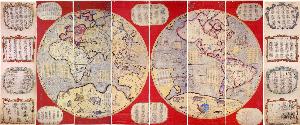Ferdinand Verbiest
Nan Huairen;Ferdinand Verbiest
Place: Pittem
Born: 1623
Death: 1688
Biography:
Ferdinand Verbiest was a Flemish Jesuit missionary, mathematician, and astronomer who lived in China during the Qing dynasty. Born on October 9, 1623, in Pittem near Tielt in the County of Flanders (now part of Belgium), he is known as Nan Huairen (南懷仁) in Chinese.
Early Life and Education
Verbiest joined the Society of Jesus in 1641 and was ordained as a priest in 1650. He then traveled to China, where he became a close friend and advisor to the Kangxi Emperor. Verbiest's expertise in mathematics and astronomy led him to correct the Chinese calendar and rebuild the Beijing Ancient Observatory.
Artistic Contributions
Verbiest was also an accomplished artist, and his works can be found in various museums, including the Kobe City Museum. One of his notable works is the Map of the World, a woodblock print that showcases his knowledge of cartography. To learn more about Verbiest's artistic contributions, visit the Ferdinand Verbiest: Map of the World page on Wikioo.org.
Relationship with the Kangxi Emperor
Verbiest's relationship with the Kangxi Emperor was significant, and he often instructed the emperor in geometry, philosophy, and music. The emperor frequently requested Verbiest's presence, and their friendship led to a deeper understanding between the Chinese and European cultures.
Legacy
Verbiest wrote over 30 books during his lifetime, including works on mathematics, astronomy, and music. His legacy extends beyond his artistic contributions, as he played a crucial role in introducing European astronomy to China. To learn more about Verbiest's life and work, visit the Ferdinand Verbiest page on Wikioo.org.
- Ferdinand Verbiest was a Flemish Jesuit missionary and artist who lived in China during the Qing dynasty.
- He was born on October 9, 1623, in Pittem near Tielt in the County of Flanders (now part of Belgium).
- Verbiest joined the Society of Jesus in 1641 and was ordained as a priest in 1650.
- He became a close friend and advisor to the Kangxi Emperor, correcting the Chinese calendar and rebuilding the Beijing Ancient Observatory.
- Verbiest's artistic works can be found in various museums, including the Kobe City Museum.
To learn more about the Society of Jesus, visit the Jesuits page on Wikipedia. For information on the relationship between science and the Catholic Church, visit the Science and the Catholic Church page on Wikipedia.

